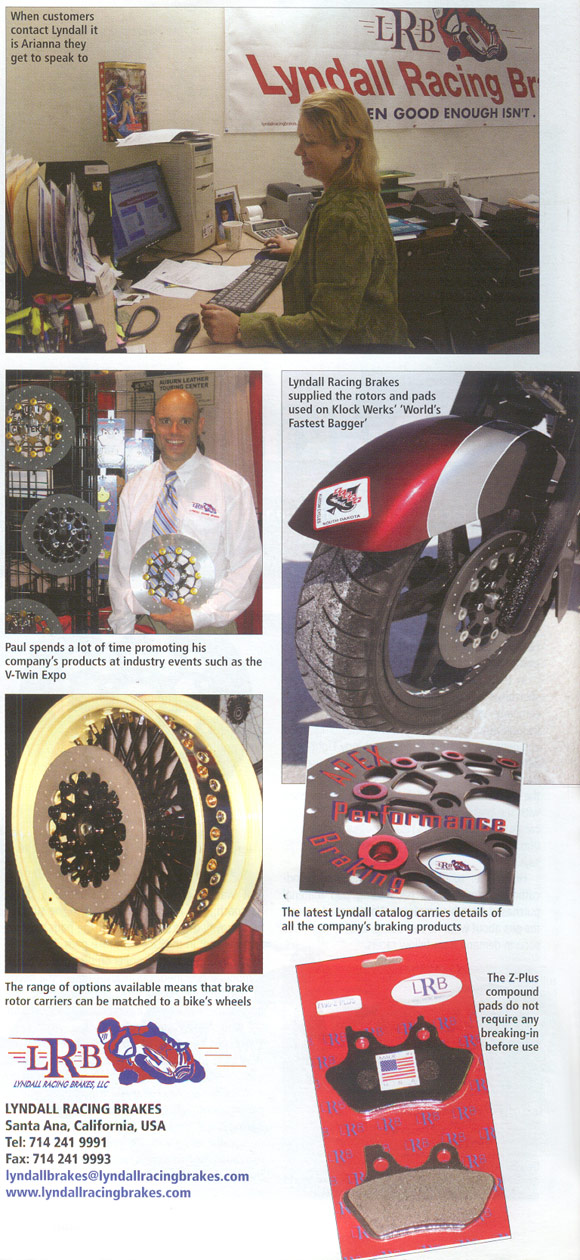| |
American
Motorcycle Dealer - August,
'07 > Product Review
|
Out
Braking the Competition
Lyndall
Racing Brakes LLC
800.400.9490
www.lyndallracingbrakes.com
Written
by Duncan More
Interview &
Photography
by Chris McGee |
| |
|
|
Lyndall
RAcing Brakes, which began
with club level racer
Paul Kitrell trying to
improve the brakes on
his race bike, is a leading
supplier of high-performance
pads and rotors for all
models of Harley-Davidsons.
Chris McGee discovers
what it takes to out-brake
the competition.
Paul
Kitrell and Arianna Orner
are the couple behind
Lyndall Racing Brakes
(LRB), which is now celebrating
its tenth year in business,
but the story of the company
began long before that.
In
1996 Paul was a club level
racer riding 600cc sportbikes
at Willow Springs, while
working for a company
which supplied brake components
to various automotive
racing teams, including
those competing in Formula
Atlantic and Indy Light
open wheel car racing.
However, the technology
used on the bikes didn't
match what he saw being
used on the cars. "As
a racer at club level
I was unimpressed with
the brake pads available
compared with their car
equivalents. They had
carbon-Kevlar with trace
iron compound pads, which
were really effective,"
he says.
His
answer to the problem
was to start hand-cutting
his own brake pads using
pad material purchased
from his employer. Word
spread around the pits
about what he was doing,
and his work was soon
in demand from fellow
racers.
It
was at this point
that he made a direct
approach, with his
boss's approval,
to the supplier
who provided the
compound for the
pads used by his
employer in the
race car brake pads.
This led to him
working with the
supplier on developing
a new compound designed
specifically to
meet the needs of
motorcycle riders.
The next stage of
the development
work was a compound
specifically for
use with stainless
steel brake rotors.
Within
two years of cutting
his first pads,
Paul was in a position
where he had to
make a decision
about his future;
remain an employee
or go it alone.
The decision he
made was to approach
his parents, and
with their help
established Lyndall
Racing Brakes. Paul
says: "My dad's
background was in
manufacturing with
an emphasis on sales
and marketing. He
had always been
supportive, and
now that he was
retired he had time
on his hands, so
he was able to help
me alot when we
started." That
was in 1998 with
a line of sport
bike brake pads,
and by 1999 LRB
had begun supplying
local Harley-Davidson
dealerships with
a line of replacement
pads for those too.
|
|
Such
has been the success of
the company that today
authorized H-D dealerships
from San Marino to San
Diego only stock two types
of brake pad: OE or Lyndall.
An impressive statistic
given that dealers receive
loyalty points for all
OE equipment they sell.
Paul puts this success
down to the effectiveness
of the pads claiming 30
percent stopping power
over stock items. Other
claimed benefits include
no brake dust and no damage
to the rotors.
Lyndall
racing brakes are available
in three different compounds:
Gold, Z-Plus and Red-Plus.
The Gold compound is the
company's original pad
derived from Formula Atlantic
and Indy Light open wheel
car racing. The friction
material is a proprietary
blend of carbon-Kevlar
and trace iron, which
LRB claims excels in extreme
environments and after
a break-in period generally
averages about 7,000 to
10,000 miles. The Z-Plus
compound is a softened
version of the Gold compound
and as such does not require
the break-in period. It
is recommended for general
purpose riding and offers
a high coefficient of
friction, and is claimed
to be the most rotor friendly
pad in the industry; producing
no dust, no rotor wear,
and no noise. The final
compound available is
the Red-Plus, specifically
designed to complement
metal matrix composite
rotors. LRB says it provides
the highest coefficient
of friction, the longest
service life, and runs
cleaner and quieter than
any other composite-specific
pad available.
Given
that Lyndall Racing Brakes
supplies pads for use
with composite rotors,
it should come as no surprise
that is also supplies
such discs. Called Apex
Performance Rotors, they
are made of an allow of
80 percent aluminum and
20 percent silicon carbide.
The way in which they
are manufactured differs
from other rotors, in
that they are spun cast.
The benefit of this manufacturing
process is that it places
the maximum ceramic content
at the outer edge of the
rotor; the area most affected
by heat build-up. Arianna
Orner, Paul's partner
and company CFO, explains
the benefits of the LRB
Apex rotors: "Some
ceramic rotors have problems
with the surface cracking
but our manufacturing
process avoids this issue.
That's not to say we haven't
had failures in the past,
but we've learnt from
them.
In
addition to the claimed
performance benefits of
the replacement discs
they also have the advantage
of reducing the unsprung
mass on a bike's front
end. A standard OEM disc
weighs 3.8lb, whereas
a LRB Apex disc, which
is a fully floating design,
is just 1.6lb. Due to
the modular construction
of the disc, parts are
interchangeable, giving
people the choice of carrier
color and the ability
to swap from ceramic to
stainless rotors of vice
versa. Seventy series
aluminum fittings are
also used throughout for
the fitting on the discs.
The
current line-up of Lyndall
Racing Brakes' Apex and
stainless brake discs
includes applications
for all Harley-Davidson
models, including V-Rods
and Buell, as well as
American IronHorse, Big
Dog and Victory. The discs
are also compatible with
Performance Machine, Brembo,
JayBrake and HHI aftermarket
applications.
Paul
is so confident of the
product Lyndall Racing
Brakes supplies that he
says: "If a customer
isn't satisfied with the
product, I'll buy it back
from him. When a customer
comes to us he doesn't
buy a brake product, he
buys a brake company!"

Download
Our Brochure:
Apex
Performance Braking
 |